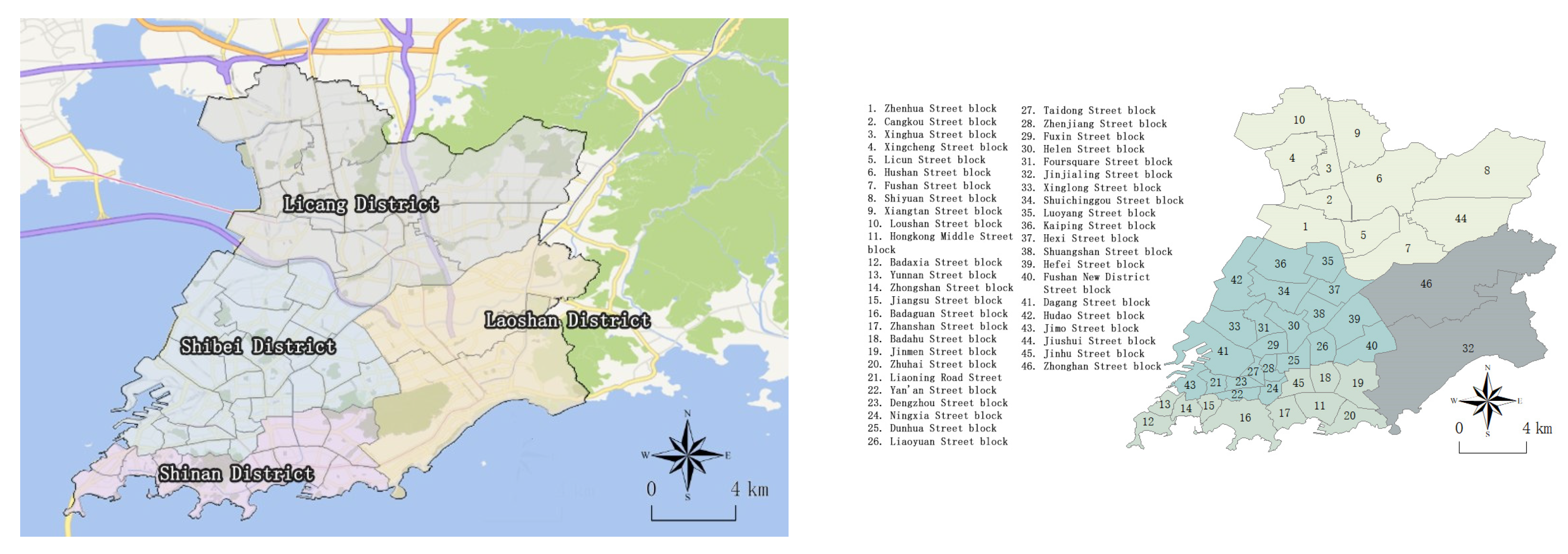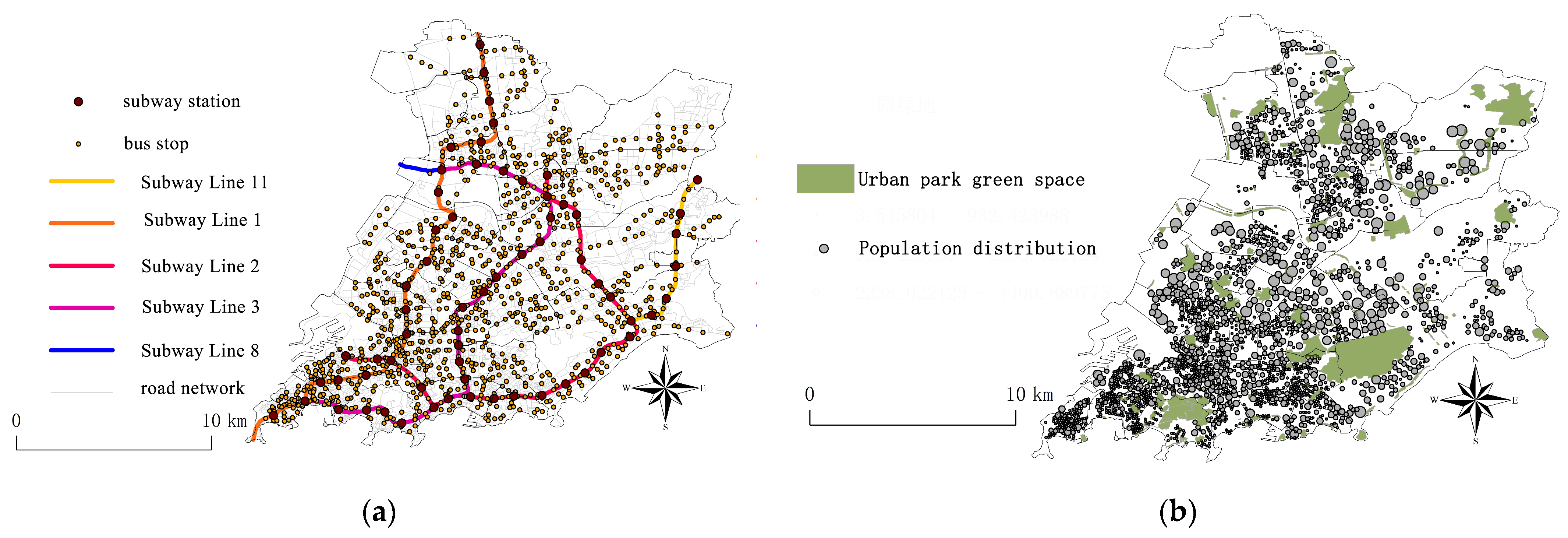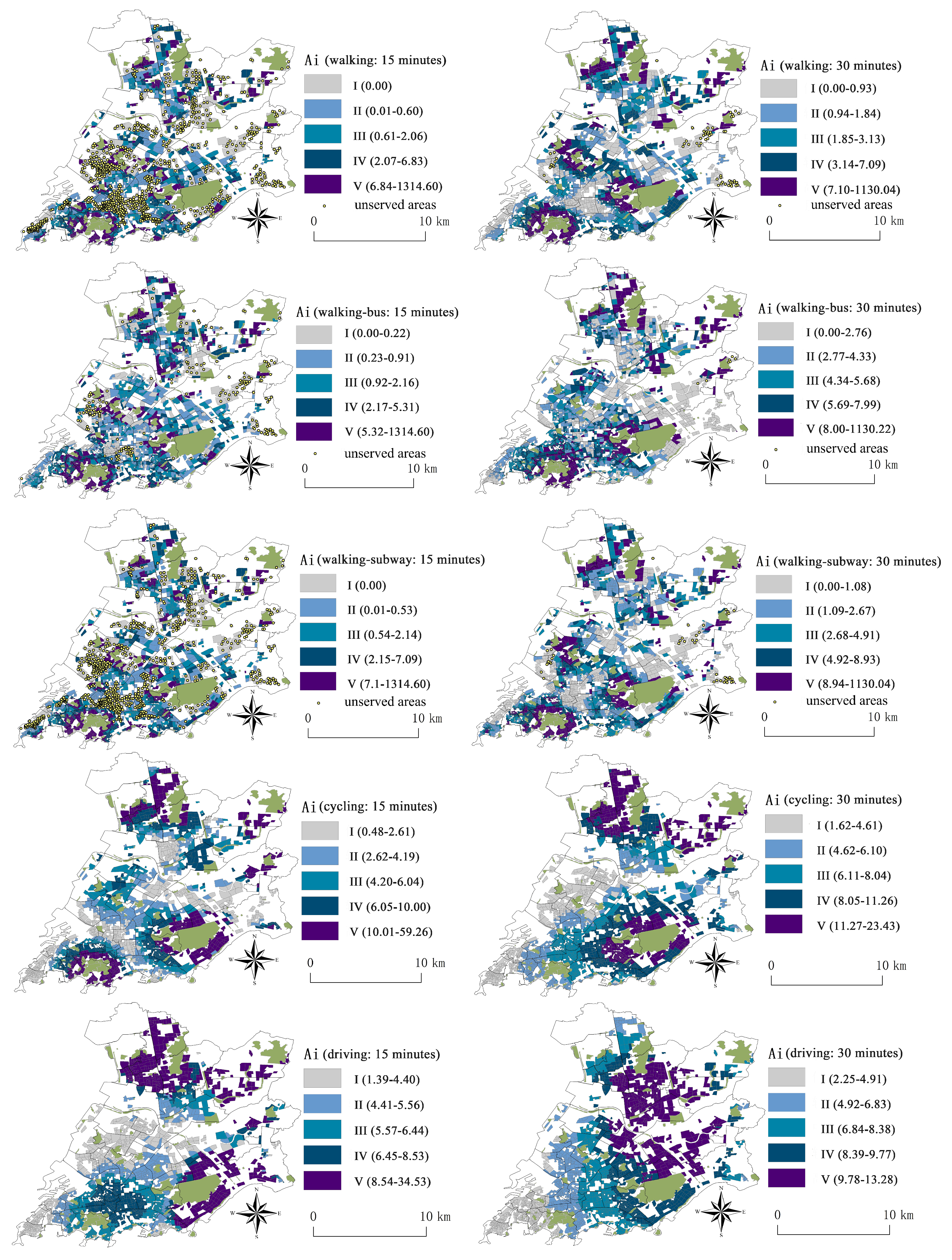Spatial Justice of Urban Park Green Space under Multiple Travel Modes and at Multiple Scales: A Case Study of Qingdao City Center, China
Abstract
1. Introduction
2. Materials and Methods
2.1. Study Area
2.2. Research Methods and Data Processing
2.2.1. Research Method
Travel-Behavior-Based Gaussian Two-Step Floating Catchment Area Method (TB-G2SFCA)
Gini Coefficient Method
2.2.2. Data Acquisition and Processing
Data Acquisition and Processing of Population
Data Acquisition and Processing of Urban Park Green Space (UPGS)
Data Acquisition and Processing of Visitor Travel and Road Network
3. Results
3.1. Accessibility of UPGS at the Scale of Residential Areas
3.2. Justice Analysis of Park Green Space at Street Block Scale
3.3. Justice Analysis of Park Green Space at District Level Scale
4. Discussion
5. Conclusions
Author Contributions
Funding
Institutional Review Board Statement
Informed Consent Statement
Data Availability Statement
Conflicts of Interest
Appendix A
| 1. What is the purpose of travel to parks? |
| □ Sightseeing □ Exercise and Fitness □ Community activity □ Scientific research □ Photography |
| 2. Where do you reside? |
| □ Shinan □ Shibei □ Licang □ Laoshan □ Chenyang □ Jimo □ Huangdao □ other |
| 3. How long does it take to get from residential area to the park? |
| □ 10 min □ 30 min □ 1 h □ 2 h □ 3 h □ 4 h □ 5 h □ >5 h |
| 4. Your travel mode to arrive at the park? |
| □ Bus/Subway □ Driving □ Cycling □ Walking □ Combination □ Other |
| 5. How much does it cost to get from residential area to the park? |
| □ CNY 0 □ CNY 2 □ CNY 4 □ CNY 6 □ CNY 8 □ CNY 10 □ CNY 20 □ CNY 40 □ CNY 60 □ CNY 60 □ CNY 80 □ CNY 100 □ More |
| 6. How often do you go to the park? |
| □ Every day □ Twice a week □ Once a week □ Twice a month □ Once a month □ Twice a year □ Once a year □ Other |
| 7. How much time do you spend at the park? |
| □ 15 min □ 40 min □ 1 h □ 2 h □ 3 h □ 4 h □ 5 h □ More |
| 8. How much do you spend at the park? |
| □ CNY 0 □ CNY 1–10 □ CNY 11–20 □ CNY 21–30 □ CNY 31–40 □ CNY 41–50 □ CNY 51–70 □ CNY 71–100 □ CNY 101–200 □More |
| 9. The level of satisfaction at the park? |
| □ Quite satisfactory □ Relatively satisfactory □ satisfactory □ Relatively unsatisfactory □ Quite unsatisfactory |
| 10. Willingness to pay for the park experience? |
| □ CNY 0 □ CNY 1–100 □ CNY 101–500 □ CNY 501–1000 □ More |
| 11. Gender and age |
| □ Male □ Female □ <18 □ 18–25 □ 26–45 □ 46–60 □ >60 |
| 12. Level of education |
| □ Junior high school and below □ high school or vocational school □ college degree □ graduate degree |
| 13. Monthly income level |
| □ ≤CNY 1000 □ CNY 1001–2000 □ CNY 2001–3000 □ CNY 3001–4000 □ CNY 4001–5000 □ CNY 4001–5000 □ CNY 5001–8000 □ More |
References
- Guan, J.; Wang, R.; Van Berkel, D.; Liang, Z. How spatial patterns affect urban green space equity at different equity levels: A Bayesian quantile regression approach. Landsc. Urban Plan. 2023, 233, 104709. [Google Scholar] [CrossRef]
- Pinto, L.V.; Inácio, M.; Ferreira, C.S.S.; Ferreira, A.D.; Pereira, P. Ecosystem services and well-being dimensions related to urban green spaces—A systematic review. Sustain. Cities Soc. 2022, 85, 104072. [Google Scholar] [CrossRef]
- Muluneh, M.G.; Worku, B.B. Contributions of urban green spaces for climate change mitigation and biodiversity conservation in Dessie city, Northeastern Ethiopia. Urban Clim. 2022, 46, 101294. [Google Scholar] [CrossRef]
- Zhu, X.; Cheng, X.; Zhang, B.; Mihalko, C. A user-feedback indicator framework to understand cultural ecosystem services of urban green space. Ecol. Indic. 2023, 154, 110642. [Google Scholar] [CrossRef]
- Buchel, S.; Frantzeskaki, N. Citizens’ voice: A case study about perceived ecosystem services by urban park users in Rotterdam, the Netherlands. Ecosyst. Serv. 2015, 12, 169–177. [Google Scholar] [CrossRef]
- Khotdee, M.; Singhirunnusorn, W.; Sahachaisaeree, N. Effects of Green Open Space on Social Health and Behaviour of Urban Residents: A Case Study of Communities in Bangkok. Procedia Soc. Behav. Sci. 2012, 36, 449–455. [Google Scholar] [CrossRef]
- Wolch, J.R.; Byrne, J.; Newell, J.P. Urban green space, public health, and environmental justice: The challenge of making cities ‘just green enough’. Landsc. Urban Plan. 2014, 125, 234–244. [Google Scholar] [CrossRef]
- Xing, L.; Liu, Y.; Wang, B.; Wang, Y.; Liu, H. An environmental justice study on spatial access to parks for youth by using an improved 2SFCA method in Wuhan, China. Cities 2020, 96, 102405. [Google Scholar] [CrossRef]
- Xiao, Y.; Wang, Z.; Li, Z.G.; Tang, Z.L. An assessment of urban park access in Shanghai—Implications for the social equity in urban China. Landsc. Urban Plan. 2017, 157, 383–393. [Google Scholar] [CrossRef]
- Grant, A.; Millward, A.A.; Edge, S.; Roman, L.A.; Teelucksingh, C. Where is environmental justice? A review of US urban forest management plans. Urban For. Urban Green. 2022, 77, 127737. [Google Scholar] [CrossRef]
- Gebeyehu, B.; Adugna, B.; Gammie, T.; Simane, B.; Mekuriaw, A. Environmental Justice and Sustainable Development. In Encyclopedia of Sustainability in Higher Education; Leal Filho, W., Ed.; Springer International Publishing: Cham, Switzerland, 2019; pp. 1–9. [Google Scholar]
- Liu, D.; Kwan, M.-P.; Kan, Z. Analysis of urban green space accessibility and distribution inequity in the City of Chicago. Urban For. Urban Green. 2021, 59, 127029. [Google Scholar] [CrossRef]
- Jung, E. Green spaces for whom? A latent profile analysis of park-rich or -deprived neighborhoods in New York City. Landsc. Urban Plan. 2023, 237, 104806. [Google Scholar] [CrossRef]
- Zhai, T.; Wang, J.; Jin, Z.; Qi, Y.; Fang, Y.; Liu, J. Did improvements of ecosystem services supply-demand imbalance change environmental spatial injustices? Ecol. Indic. 2020, 111, 106068. [Google Scholar] [CrossRef]
- Amaral, M.H.; Benites-Lazaro, L.L.; Antonio de Almeida Sinisgalli, P.; Prates da Fonseca Alves, H.; Giatti, L.L. Environmental injustices on green and blue infrastructure: Urban nexus in a macrometropolitan territory. J. Clean. Prod. 2021, 289, 125829. [Google Scholar] [CrossRef]
- Kronenberg, J.; Haase, A.; Łaszkiewicz, E.; Antal, A.; Baravikova, A.; Biernacka, M.; Dushkova, D.; Filčak, R.; Haase, D.; Ignatieva, M.; et al. Environmental justice in the context of urban green space availability, accessibility, and attractiveness in postsocialist cities. Cities 2020, 106, 102862. [Google Scholar] [CrossRef]
- Ghasemi, K.; Behzadfar, M.; Borhani, K.; Nouri, Z. Geographic information system based combined compromise solution (CoCoSo) method for exploring the spatial justice of accessing urban green spaces, a comparative study of district 22 of Tehran. Ecol. Indic. 2022, 144, 109455. [Google Scholar] [CrossRef]
- Black, J.; Conroy, M. Accessibility Measures and the Social Evaluation of Urban Structure. Environ. Plan. A Econ. Space 1977, 9, 1013–1031. [Google Scholar] [CrossRef]
- Handy, S.L. Regional Versus Local Accessibility: Implications for Nonwork Travel. Transp. Res. Rec. 1993, 1400, 58–66. [Google Scholar]
- Handy, S.L.; Niemeier, D.A. Measuring Accessibility: An Exploration of Issues and Alternatives. Environ. Plan. A 1997, 29, 1175–1194. [Google Scholar] [CrossRef]
- Li, Z.; Fan, Z.; Song, Y.; Chai, Y. Assessing equity in park accessibility using a travel behavior-based G2SFCA method in Nanjing, China. J. Transp. Geogr. 2021, 96, 103179. [Google Scholar] [CrossRef]
- Zhang, F.; Li, D.; Ahrentzen, S.; Zhang, J. Assessing spatial disparities of accessibility to community-based service resources for Chinese older adults based on travel behavior: A city-wide study of Nanjing, China. Habitat Int. 2019, 88, 101984. [Google Scholar] [CrossRef]
- Páez, A.; Scott, D.M.; Morency, C. Measuring accessibility: Positive and normative implementations of various accessibility indicators. J. Transp. Geogr. 2012, 25, 141–153. [Google Scholar] [CrossRef]
- Pei, X.R.; Guo, P.; Chen, Q.Y.; Li, J.R.; Liu, Z.F.; Sun, Y.L.; Zhang, X.K. An Improved Multi-Mode Two-Step Floating Catchment Area Method for Measuring Accessibility of Urban Park in Tianjin, China. Sustainability 2022, 14, 11592. [Google Scholar] [CrossRef]
- Geurs, K.T.; van Wee, B. Accessibility evaluation of land-use and transport strategies: Review and research directions. J. Transp. Geogr. 2004, 12, 127–140. [Google Scholar] [CrossRef]
- Chen, Y.; Ge, Y.; Yang, G.; Wu, Z.; Du, Y.; Mao, F.; Liu, S.; Xu, R.; Qu, Z.; Xu, B.; et al. Inequalities of urban green space area and ecosystem services along urban center-edge gradients. Landsc. Urban Plan. 2022, 217, 104266. [Google Scholar] [CrossRef]
- Phillips, A.; Canters, F.; Khan, A.Z. Analyzing spatial inequalities in use and experience of urban green spaces. Urban For. Urban Green. 2022, 74, 127674. [Google Scholar] [CrossRef]
- Gupta, K.; Kumar, P.; Pathan, S.K.; Sharma, K.P. Urban Neighborhood Green Index—A measure of green spaces in urban areas. Landsc. Urban Plan. 2012, 105, 325–335. [Google Scholar] [CrossRef]
- Zhang, R.; Peng, S.; Sun, F.; Deng, L.; Che, Y. Assessing the social equity of urban parks: An improved index integrating multiple quality dimensions and service accessibility. Cities 2022, 129, 103839. [Google Scholar] [CrossRef]
- Wu, L.; Kim, S.K.; Lin, C. Socioeconomic groups and their green spaces availability in urban areas of China: A distributional justice perspective. Environ. Sci. Policy 2022, 131, 26–35. [Google Scholar] [CrossRef]
- Xiao, Y.; Wang, D.; Fang, J. Exploring the disparities in park access through mobile phone data: Evidence from Shanghai, China. Landsc. Urban Plan. 2019, 181, 80–91. [Google Scholar] [CrossRef]
- Chen, J.; Chang, Z. Rethinking urban green space accessibility: Evaluating and optimizing public transportation system through social network analysis in megacities. Landsc. Urban Plan. 2015, 143, 150–159. [Google Scholar] [CrossRef]
- Dony, C.C.; Delmelle, E.M.; Delmelle, E.C. Re-conceptualizing accessibility to parks in multi-modal cities: A Variable-width Floating Catchment Area (VFCA) method. Landsc. Urban Plan. 2015, 143, 90–99. [Google Scholar] [CrossRef]
- Nghiem, L.T.P.; Zhang, Y.; Oh, R.R.Y.; Chang, C.-c.; Tan, C.L.Y.; Shannahan, D.F.; Lin, B.B.; Gaston, K.J.; Fuller, R.A.; Carrasco, L.R. Equity in green and blue spaces availability in Singapore. Landsc. Urban Plan. 2021, 210, 104083. [Google Scholar] [CrossRef]
- Li, Q.; Peng, K.; Cheng, P. Community-Level Urban Green Space Equity Evaluation Based on Spatial Design Network Analysis (sDNA): A Case Study of Central Wuhan, China. Int. J. Environ. Res. Public Health 2021, 18, 10174. [Google Scholar] [CrossRef]
- Tannous, H.O.; Major, M.D.; Furlan, R. Accessibility of green spaces in a metropolitan network using space syntax to objectively evaluate the spatial locations of parks and promenades in Doha, State of Qatar. Urban For. Urban Green. 2021, 58, 126892. [Google Scholar] [CrossRef]
- Wu, J.; Peng, Y.; Liu, P.; Weng, Y.; Lin, J. Is the green inequality overestimated? Quality reevaluation of green space accessibility. Cities 2022, 130, 103871. [Google Scholar] [CrossRef]
- Hu, S.; Song, W.; Li, C.; Lu, J. A multi-mode Gaussian-based two-step floating catchment area method for measuring accessibility of urban parks. Cities 2020, 105, 102815. [Google Scholar] [CrossRef]
- Wu, J.; Chen, H.; Wang, H.; He, Q.; Zhou, K. Will the opening community policy improve the equity of green accessibility and in what ways?—Response based on a 2-step floating catchment area method and genetic algorithm. J. Clean. Prod. 2020, 263, 121454. [Google Scholar]
- Boyce, J.K.; Zwickl, K.; Ash, M. Measuring environmental inequality. Ecol. Econ. 2016, 124, 114–123. [Google Scholar] [CrossRef]
- Shu, H.; Xiong, P. The Gini coefficient structure and its application for the evaluation of regional balance development in China. J. Clean. Prod. 2018, 199, 668–686. [Google Scholar] [CrossRef]
- Dai, D. Racial/ethnic and socioeconomic disparities in urban green space accessibility: Where to intervene? Landsc. Urban Plan. 2011, 102, 234–244. [Google Scholar] [CrossRef]
- Dai, D. Black residential segregation, disparities in spatial access to health care facilities, and late-stage breast cancer diagnosis in metropolitan Detroit. Health Place 2010, 16, 1038–1052. [Google Scholar] [CrossRef] [PubMed]
- Castro, C.V. Optimizing nature-based solutions by combining social equity, hydro-environmental performance, and economic costs through a novel Gini coefficient. J. Hydrol. X 2022, 16, 100127. [Google Scholar] [CrossRef]
- Qingdao Municipal Statistics Bureau, National Bureau of Statistics of China. Statistical Communiqué of Qingdao on the 2021 National Economic and Social Development. 2021. Available online: http://qdsq.qingdao.gov.cn/ (accessed on 10 May 2022).
- CJJ/T85-2017; Standard for Classification of Urban Green Space. China Construction Industry Press: Beijing, China, 2017.
- Li, X.; Huang, Y.; Ma, X. Evaluation of the accessible urban public green space at the community-scale with the consideration of temporal accessibility and quality. Ecol. Indic. 2021, 131, 108231. [Google Scholar] [CrossRef]
- Tu, X.; Huang, G.; Wu, J.; Guo, X. How do travel distance and park size influence urban park visits? Urban For. Urban Green. 2020, 52, 126689. [Google Scholar] [CrossRef]
- Gong, F.-Y. Modeling walking accessibility to urban parks using Google Maps crowdsourcing database in the high-density urban environments of Hong Kong. Sci. Rep. 2023, 13, 20798. [Google Scholar] [CrossRef]
- Zhang, J.; Yu, Z.; Cheng, Y.; Chen, C.; Wan, Y.; Zhao, B.; Vejre, H. Evaluating the disparities in urban green space provision in communities with diverse built environments: The case of a rapidly urbanizing Chinese city. Build. Environ. 2020, 183, 107170. [Google Scholar] [CrossRef]
- Ode Sang, Å.; Knez, I.; Gunnarsson, B.; Hedblom, M. The effects of naturalness, gender, and age on how urban green space is perceived and used. Urban For. Urban Green. 2016, 18, 268–276. [Google Scholar] [CrossRef]
- Yang, W.; Yang, R.; Zhou, S. The spatial heterogeneity of urban green space inequity from a perspective of the vulnerable: A case study of Guangzhou, China. Cities 2022, 130, 103855. [Google Scholar] [CrossRef]





Disclaimer/Publisher’s Note: The statements, opinions and data contained in all publications are solely those of the individual author(s) and contributor(s) and not of MDPI and/or the editor(s). MDPI and/or the editor(s) disclaim responsibility for any injury to people or property resulting from any ideas, methods, instructions or products referred to in the content. |
© 2024 by the authors. Licensee MDPI, Basel, Switzerland. This article is an open access article distributed under the terms and conditions of the Creative Commons Attribution (CC BY) license (https://creativecommons.org/licenses/by/4.0/).
Share and Cite
Li, S.; Zeng, X.; Zhang, X.; Jiang, J.; Wang, F.; Zhang, T.; Zhang, J. Spatial Justice of Urban Park Green Space under Multiple Travel Modes and at Multiple Scales: A Case Study of Qingdao City Center, China. Sustainability 2024, 16, 1428. https://doi.org/10.3390/su16041428
Li S, Zeng X, Zhang X, Jiang J, Wang F, Zhang T, Zhang J. Spatial Justice of Urban Park Green Space under Multiple Travel Modes and at Multiple Scales: A Case Study of Qingdao City Center, China. Sustainability. 2024; 16(4):1428. https://doi.org/10.3390/su16041428
Chicago/Turabian StyleLi, Shimei, Xueyan Zeng, Xiaoguang Zhang, Jiancheng Jiang, Furong Wang, Tianci Zhang, and Jiacheng Zhang. 2024. "Spatial Justice of Urban Park Green Space under Multiple Travel Modes and at Multiple Scales: A Case Study of Qingdao City Center, China" Sustainability 16, no. 4: 1428. https://doi.org/10.3390/su16041428
APA StyleLi, S., Zeng, X., Zhang, X., Jiang, J., Wang, F., Zhang, T., & Zhang, J. (2024). Spatial Justice of Urban Park Green Space under Multiple Travel Modes and at Multiple Scales: A Case Study of Qingdao City Center, China. Sustainability, 16(4), 1428. https://doi.org/10.3390/su16041428





